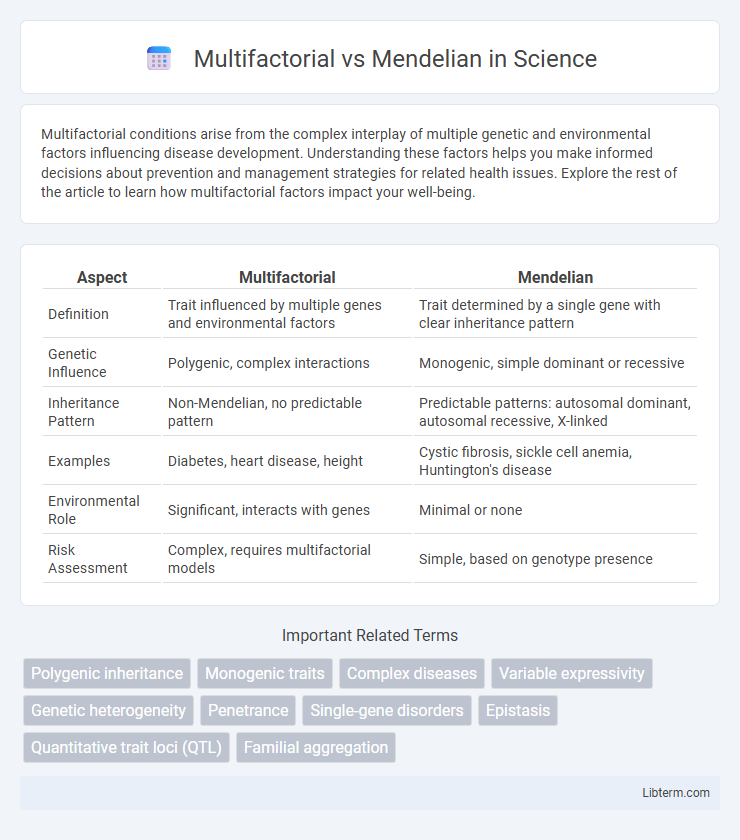Multifactorial conditions arise from the complex interplay of multiple genetic and environmental factors influencing disease development. Understanding these factors helps you make informed decisions about prevention and management strategies for related health issues. Explore the rest of the article to learn how multifactorial factors impact your well-being.
Table of Comparison
| Aspect | Multifactorial | Mendelian |
|---|---|---|
| Definition | Trait influenced by multiple genes and environmental factors | Trait determined by a single gene with clear inheritance pattern |
| Genetic Influence | Polygenic, complex interactions | Monogenic, simple dominant or recessive |
| Inheritance Pattern | Non-Mendelian, no predictable pattern | Predictable patterns: autosomal dominant, autosomal recessive, X-linked |
| Examples | Diabetes, heart disease, height | Cystic fibrosis, sickle cell anemia, Huntington's disease |
| Environmental Role | Significant, interacts with genes | Minimal or none |
| Risk Assessment | Complex, requires multifactorial models | Simple, based on genotype presence |
Introduction to Genetic Inheritance
Genetic inheritance involves the transmission of traits through DNA from parents to offspring, with Mendelian inheritance describing traits controlled by a single gene following dominant or recessive patterns. Multifactorial inheritance involves multiple genes and environmental factors contributing to complex traits or diseases, such as heart disease or diabetes. Understanding the difference highlights the simplicity of Mendelian inheritance versus the complex interplay in multifactorial inheritance affecting phenotype expression.
Defining Mendelian Inheritance
Mendelian inheritance refers to the transmission of traits controlled by a single gene with clear dominant or recessive alleles, following Gregor Mendel's laws of segregation and independent assortment. This pattern results in predictable phenotypic ratios in offspring, such as the classic 3:1 ratio in monohybrid crosses. In contrast, multifactorial inheritance involves multiple genes and environmental factors contributing to complex traits and diseases, leading to variable phenotypes that do not adhere to simple Mendelian ratios.
Key Principles of Multifactorial Inheritance
Multifactorial inheritance involves the interaction of multiple genes and environmental factors contributing to a trait, unlike Mendelian inheritance which is determined by single genes with clear dominant or recessive patterns. Key principles include the polygenic nature, where several genes influence a trait simultaneously, and the impact of environmental modifiers that alter phenotypic expression. Multifactorial traits often show continuous variation and familial aggregation without a predictable Mendelian ratio, making risk assessment complex.
Major Differences: Mendelian vs Multifactorial Traits
Mendelian traits are determined by a single gene with clear dominant or recessive inheritance patterns, while multifactorial traits result from the combined effects of multiple genes and environmental factors, making their inheritance complex and variable. Mendelian disorders typically follow predictable ratios in offspring, such as autosomal dominant or recessive, whereas multifactorial traits, like height or diabetes, show continuous variation and a less predictable familial aggregation. The major difference lies in Mendelian traits' direct gene-trait link versus the polygenic and environmental interplay characterizing multifactorial traits.
Common Mendelian Disorders
Common Mendelian disorders are caused by mutations in a single gene and follow predictable inheritance patterns such as autosomal dominant, autosomal recessive, or X-linked. Examples include cystic fibrosis, sickle cell anemia, and Huntington's disease, which exhibit clear genotype-phenotype correlations. In contrast, multifactorial disorders arise from the interaction of multiple genes and environmental factors, making their inheritance patterns complex and less predictable.
Examples of Multifactorial Diseases
Multifactorial diseases result from the interaction of multiple genes and environmental factors, making conditions like type 2 diabetes, coronary artery disease, and hypertension common examples. Unlike Mendelian diseases, which follow a clear inheritance pattern such as cystic fibrosis or Huntington's disease, multifactorial disorders display complex inheritance with variable expression. These multifactorial diseases often involve polygenic risk factors combined with lifestyle influences, complicating prediction and prevention efforts.
Genetic and Environmental Interactions
Multifactorial traits result from complex interactions between multiple genes and environmental factors, making their inheritance patterns less predictable than Mendelian traits, which are determined by single genes with clear dominant or recessive alleles. Genetic variations in multifactorial disorders influence susceptibility rather than direct causation, with environmental triggers playing a critical role in expression and severity. Understanding these gene-environment interactions is essential for studying diseases like diabetes, heart disease, and many psychiatric conditions, where both hereditary predispositions and lifestyle choices contribute significantly.
Inheritance Patterns and Risk Predictions
Multifactorial inheritance involves multiple genes and environmental factors contributing to disease risk, resulting in complex, non-Mendelian patterns that make precise predictions challenging. Mendelian inheritance follows clear dominant, recessive, or X-linked gene transmission patterns, allowing for more straightforward risk estimation using pedigrees or genetic testing. Risk prediction in multifactorial conditions relies on polygenic risk scores and environmental assessments, whereas Mendelian disorders benefit from deterministic genetic markers with high predictive value.
Implications for Genetic Counseling
Multifactorial and Mendelian inheritance patterns significantly influence genetic counseling approaches by determining risk assessment accuracy and recurrence probabilities for families. In Mendelian conditions, mutations in a single gene provide clearer predictive information for inheritance patterns, enabling more precise risk estimates and targeted testing strategies. Multifactorial disorders involve complex interactions between multiple genes and environmental factors, complicating risk predictions and necessitating broader counseling that addresses lifestyle, environmental modifications, and probabilistic rather than deterministic outcomes.
Future Directions in Genetic Research
Future directions in genetic research emphasize integrating multifactorial models with advanced genomic technologies to unravel complex trait etiologies beyond single-gene Mendelian patterns. High-throughput sequencing combined with machine learning algorithms enables identification of gene-environment interactions and polygenic risk scores, enhancing predictive accuracy for multifactorial diseases. Continued development of CRISPR-based functional assays and large-scale biobank data will facilitate precise therapeutic targets, bridging Mendelian insights with multifactorial genetic architectures.
Multifactorial Infographic

 libterm.com
libterm.com